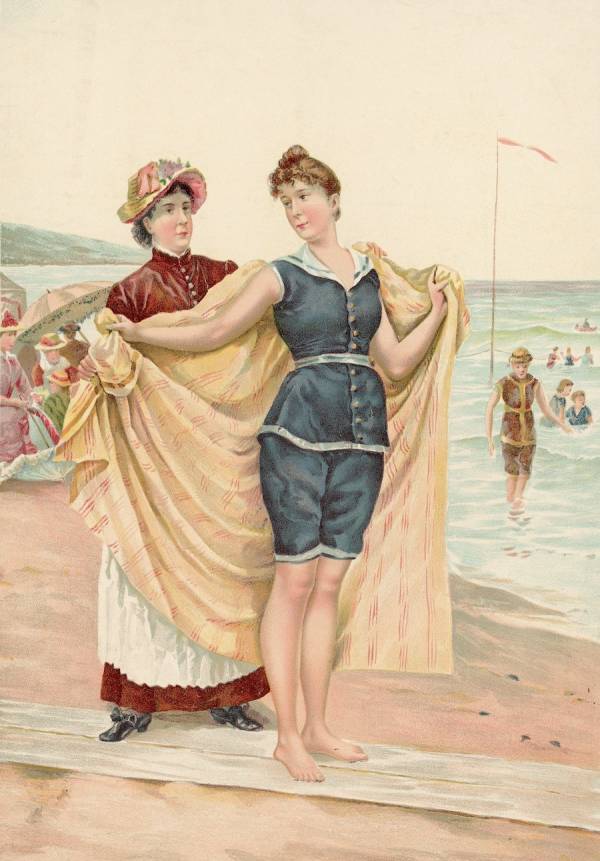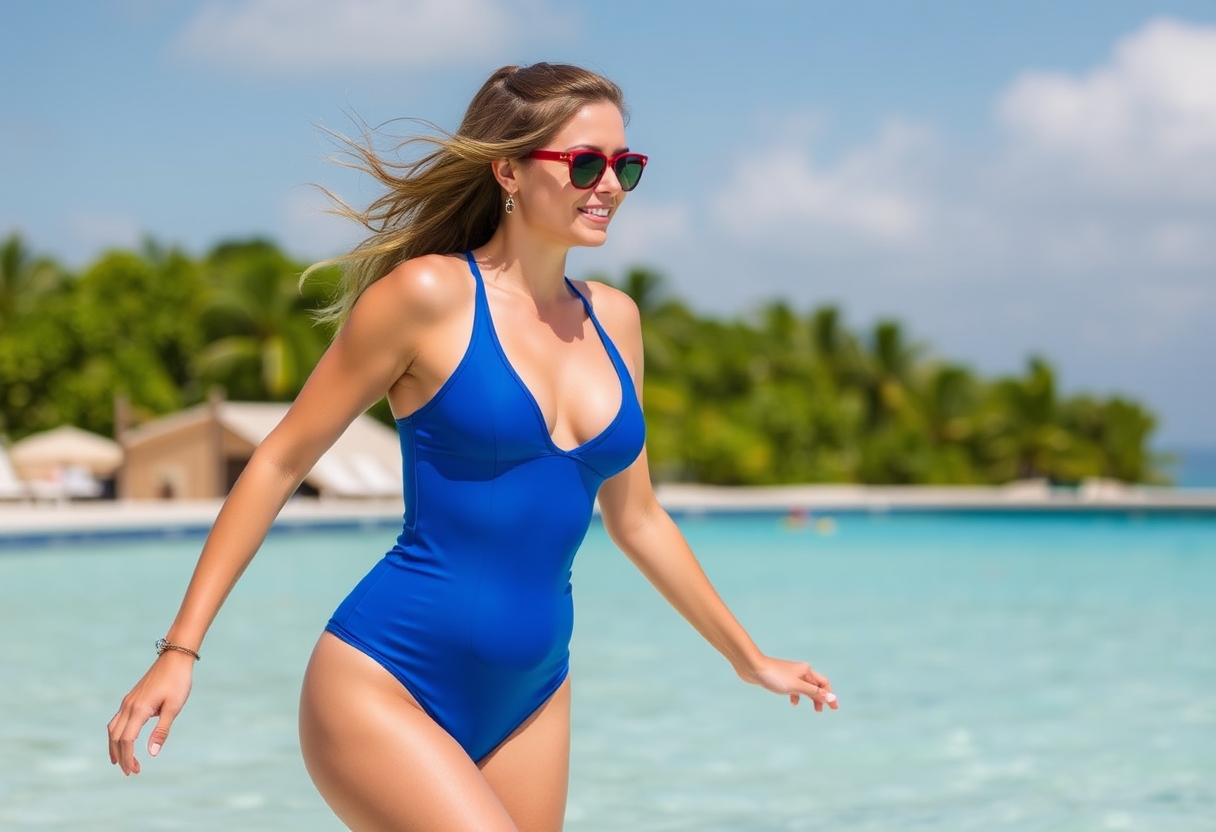Content Menu
● The Victorian Era: Modesty Meets the Sea
● The Roaring Twenties: A Breath of Fresh Air
● The 1930s and 1940s: Hollywood Glamour Meets Functionality
● The 1950s: The Birth of the Bikini
● The 1980s: High-Cut Glamour
● The 1990s and 2000s: Minimalism and Sport-Inspired Designs
● The Modern Era: Diversity and Sustainability
● Conclusion: The Future of Snazzy Swimwear
The world of swimwear has always been a fascinating reflection of society's evolving attitudes towards fashion, body image, and leisure. From the modest bathing dresses of the Victorian era to the daring bikinis of the modern age, the journey of the swimsuit is a tale of innovation, liberation, and style. In this article, we'll dive into the captivating history of swimwear, exploring how it has transformed over the decades to become increasingly snazzy, functional, and expressive.

The Victorian Era: Modesty Meets the Sea
Our journey begins in the Victorian era, a time when modesty was paramount, even at the beach. Women's swimwear in this period was far from what we would consider "snazzy" today. Instead, it consisted of long, voluminous dresses made of heavy fabrics like wool or flannel. These bathing costumes were designed to conceal rather than reveal, often featuring long sleeves, high necklines, and skirts that reached below the knees.
Imagine trying to swim in such an outfit! These cumbersome garments were not only impractical for swimming but also potentially dangerous. When wet, they became incredibly heavy, making it difficult for women to move freely in the water. Despite these drawbacks, the Victorian bathing dress was considered the height of beach fashion at the time.
Men's swimwear of the era was slightly less restrictive, typically consisting of a one-piece suit that covered the torso and upper thighs. However, it was still a far cry from the comfortable and stylish swimwear we know today.
The Roaring Twenties: A Breath of Fresh Air
As the 20th century dawned, societal norms began to shift, and with them, swimwear designs. The 1920s brought about a revolution in fashion, and swimwear was no exception. This era saw the birth of the modern swimsuit, with designs becoming more form-fitting and revealing.

Women's swimsuits began to show more skin, with sleeveless designs and shorter skirts becoming popular. The iconic one-piece tank suit, made famous by Australian swimmer Annette Kellerman, revolutionized women's swimwear. These suits were typically made of wool or cotton and featured a more streamlined silhouette that allowed for greater freedom of movement in the water.
Men's swimwear also underwent a transformation during this period. The one-piece suits of the Victorian era gave way to two-piece designs consisting of shorts and a sleeveless top. These new styles were not only more comfortable but also more conducive to swimming and other water activities.
The 1930s and 1940s: Hollywood Glamour Meets Functionality
The 1930s and 1940s saw swimwear becoming increasingly glamorous, influenced heavily by Hollywood starlets and pin-up culture. This era introduced us to some truly snazzy swimsuit designs that combined style with improved functionality.
Women's swimsuits became more figure-hugging, often featuring ruching and strategic cutouts to flatter the body. The introduction of lastex, a yarn with elastic properties, allowed for the creation of swimsuits that stretched and held their shape better than ever before. This innovation paved the way for more daring and form-fitting designs.
The two-piece swimsuit also made its debut during this period, although it was still relatively modest by today's standards. These early two-pieces typically featured a high-waisted bottom that covered the navel and a supportive top, offering a tantalizing glimpse of midriff while maintaining a degree of modesty.
Men's swimwear continued to evolve, with trunks becoming shorter and more fitted. The classic boxer-style swim short, which remains popular to this day, emerged during this era.
The 1950s: The Birth of the Bikini
The 1950s marked a watershed moment in swimwear history with the introduction of the bikini. Named after the Bikini Atoll, where atomic bomb tests were conducted, the bikini exploded onto the fashion scene with just as much impact.
Designed by French engineer Louis Réard in 1946, the bikini was initially met with shock and controversy. It was so scandalous that Réard had to hire a stripper to model it, as no regular fashion model would dare to wear such a revealing garment. The original bikini was a far cry from the modest two-pieces of the 1940s, featuring a bra-like top and bottoms that exposed the navel.
Despite initial resistance, the bikini gradually gained acceptance throughout the 1950s and into the 1960s. Hollywood stars like Brigitte Bardot helped popularize the style, and soon beaches around the world were dotted with these daring new swimsuits.
The 1960s and 1970s: Flower Power and Psychedelic Prints
The cultural revolution of the 1960s and 1970s had a profound impact on swimwear fashion. This era saw an explosion of color, pattern, and creativity in swimsuit design. Psychedelic prints, bold florals, and vibrant colors became the order of the day, making swimwear more eye-catching and expressive than ever before.

The bikini continued to reign supreme, but new variations emerged. The string bikini, with its minimalist design held together by thin straps, became a popular choice for those seeking maximum sun exposure. On the other end of the spectrum, the tankini – a combination of a tank-top style upper piece with bikini bottoms – offered a more modest alternative that still captured the spirit of the times.
For men, the speedo-style brief gained popularity, particularly in Europe and Australia. These snug-fitting swimsuits were a far cry from the boxer-style trunks of previous decades and reflected a growing comfort with displaying the male physique.
The 1980s: High-Cut Glamour
The 1980s brought us the era of "high-cut" swimwear. This style, characterized by leg openings that extended high above the hip bone, created the illusion of longer legs and a more streamlined silhouette. Often paired with bold colors and eye-catching patterns, these swimsuits epitomized the excess and glamour of the decade.
One-piece swimsuits made a comeback during this period, but with a decidedly more daring twist. Plunging necklines, cutout sides, and backless designs added sex appeal to the classic one-piece silhouette. The iconic red swimsuit worn by Pamela Anderson in the TV show "Baywatch" became a cultural phenomenon, inspiring countless imitations.
Men's swimwear in the 1980s saw a divide between the continuing popularity of speedo-style briefs and the resurgence of looser, surf-inspired board shorts. This dichotomy reflected the diverse beach cultures of the time, from the glamorous beaches of the Mediterranean to the laid-back surf scenes of California and Australia.

The 1990s and 2000s: Minimalism and Sport-Inspired Designs
As we moved into the 1990s and early 2000s, swimwear trends began to reflect a growing interest in athleticism and outdoor activities. Sport-inspired designs became increasingly popular, with many swimsuits incorporating features borrowed from athletic wear.
For women, the tankini gained widespread popularity, offering a versatile option that combined the coverage of a one-piece with the convenience of a two-piece. Boyshort-style bottoms also emerged as a trendy alternative to traditional bikini bottoms, appealing to those seeking a bit more coverage without sacrificing style.
Men's swimwear saw a shift towards longer, looser styles. Board shorts became the dominant trend, often featuring bold graphics and extending to the knee or below. This style, influenced by surf culture, offered a casual, relaxed look that appealed to a wide range of men.
The Modern Era: Diversity and Sustainability
In recent years, the world of swimwear has become more diverse and inclusive than ever before. Designers are creating swimsuits for a wide range of body types, recognizing that beauty comes in all shapes and sizes. High-waisted bikinis have made a comeback, offering a retro-inspired look that flatters many figures. Rash guards and swim leggings have also gained popularity, catering to those seeking sun protection or more modest options.

Sustainability has also become a key focus in swimwear design. Many brands are now using recycled materials and eco-friendly production methods to create swimsuits that are as kind to the environment as they are stylish. From bikinis made from recycled plastic bottles to swimwear crafted from regenerated nylon fibers, these innovative designs prove that fashion and sustainability can go hand in hand.
Technology has also played a role in creating snazzier swimsuits. Advanced fabrics offer improved UV protection, quick-drying capabilities, and enhanced durability. Some swimwear even incorporates smart technology, such as UV sensors that remind wearers to reapply sunscreen.
Conclusion: The Future of Snazzy Swimwear
As we look to the future, it's clear that the evolution of swimwear is far from over. From the modest bathing dresses of the Victorian era to the high-tech, eco-friendly designs of today, swimwear has continually adapted to reflect changing societal values, technological advancements, and fashion trends.
The swimsuits of tomorrow may incorporate even more advanced technologies, such as self-cleaning fabrics or designs that adapt to water temperature. We may see a further blurring of the lines between swimwear and everyday clothing, with versatile pieces that transition seamlessly from beach to street.
One thing is certain: the quest for the snazziest swimsuit will continue to drive innovation in the industry. Whether it's through bold new designs, sustainable materials, or cutting-edge technology, swimwear will always be a canvas for creativity and self-expression.
As we celebrate the rich history of swimwear and look forward to its exciting future, let's remember that the snazziest swimsuit is ultimately the one that makes you feel confident, comfortable, and ready to make a splash. So the next time you hit the beach or pool, take a moment to appreciate how far swimwear has come – and how fabulous you look in your chosen style!




































































